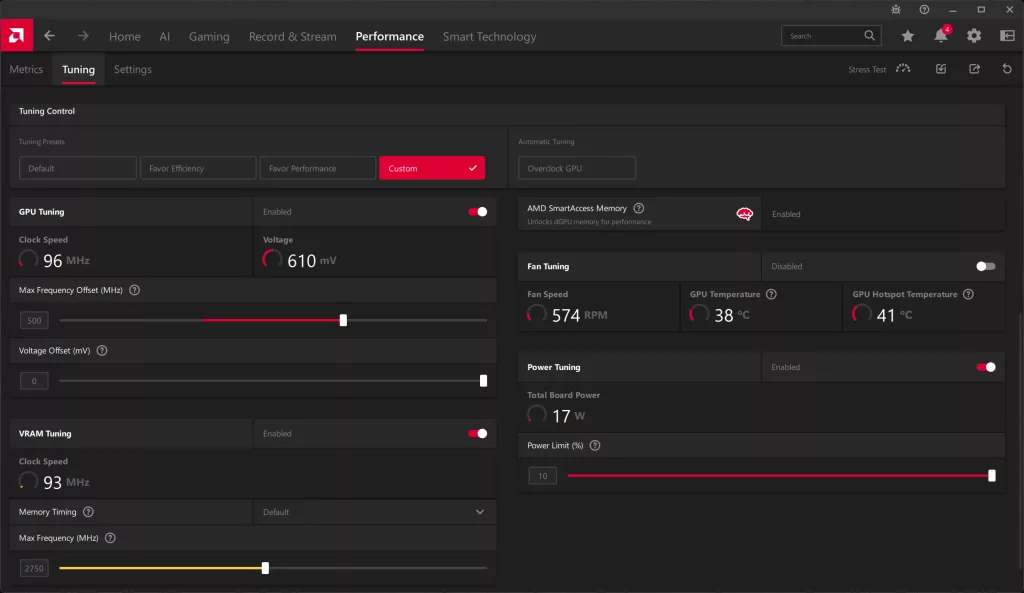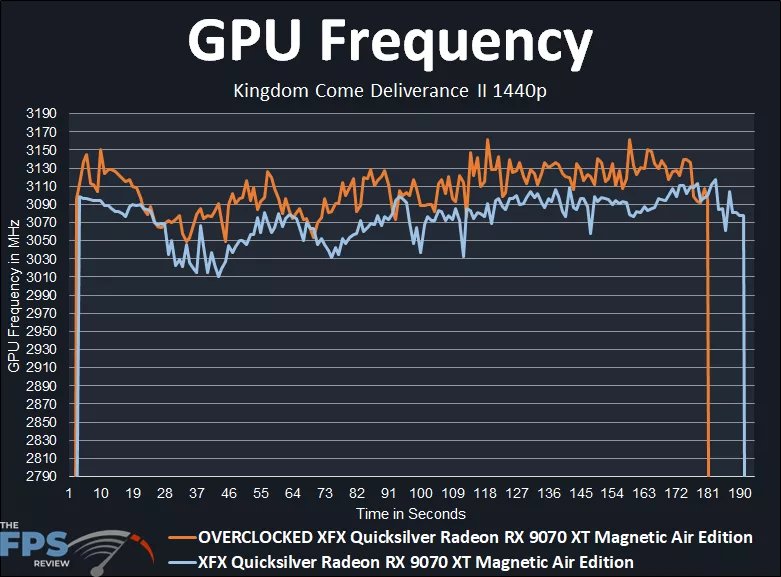Overclocking XFX Quicksilver AMD Radeon RX 9070 XT Magnetic Air Edition
To overclock the XFX Quicksilver AMD Radeon RX 9070 XT Magnetic Air Edition video card, we turned to AMD Radeon Adrenalin Software and the Performance Tuning menu to unlock custom performance tuning to adjust the Max Boost, Memory, and Power Limit.

In the screenshot above, you will see our highest stable overclock on the XFX Quicksilver AMD Radeon RX 9070 XT Magnetic Air Edition video card. Let’s walk through some of the settings. First, we were able to increase the Power Limit up by just 10%, so that does not give us a tremendous amount of power headroom, just a little bit, but not a lot. As we found out, power limiting is a major factor in the video card being able to hit its higher boost clocks and overclock past the 2970MHz set boost clock.
In terms of adjusting the GPU frequency, for this generation, it seems the only slider we have available is the Max Frequency Offset slider. Gone is the Minimum Frequency slider, which we used in the last generation video card primarily to overclock with. Now, all we can do is push up the Max Frequency Offset as far as possible, and it allows up to a maximum of 1000 on the slider. We also cannot increase the Voltage Offset, which is locked for us here, and all we can do is undervolt Voltage. We can, however, adjust the memory up pretty far; there is a lot of headroom on the slider for high memory, past what we found stable.
Our maximum overclock resulted in the Max Frequency Offset slider of +500MHz, and the memory set at 2750MHz (x8 = 22Gbps) compared to the default 20Gbps. With the memory at 22Gbps, memory bandwidth increases to 704GB/s from the default 644GB/s of bandwidth. We did try pushing the memory higher; it locked up at 23Gbps, and instant froze at 24Gbps, which we did try for funzies.
GPU Frequency
Before we dive into the GPU Frequency, we noted some interesting behaviour to report. We found that the GPU Frequency can boost differently depending on the game and resolution. For example, we got a higher reported frequency in Kingdom Come Deliverance II and some other games, and then in some other games like Cyberpunk 2077 (which we mostly use for power and temp testing), the frequency was lower. This means that we need to show both games to you below.
In addition, we found that higher resolutions have a lower GPU Boost frequency when gaming compared to lower resolutions like 1440p. The end result is that we need to show you the GPU Frequency in both Cyberpunk 2077 and Kingdom Come Deliverance II, so you can get an idea of the total range the frequency operates within at default and overclocked. Kingdom Come Deliverance II actually pushed the GPU harder in terms of a higher frequency and a higher board power draw due to the frequency being higher.

In the above graph, we are running Cyberpunk 2077 at 1440p, and this is a manual run-through. At default, the XFX Quicksilver AMD Radeon RX 9070 XT Magnetic Air Edition is operating anywhere from 2890MHz up to 3010MHz peaking, by default. Keep in mind that the boost clock is up to 2970MHz, but as you can see, it varies a lot. If we take an average of this clock speed, the average is 2952MHz, so we can see that the clock frequency does not stay at or above the rated 2970MHz by default.
When we overclock the video card with +500MHz to the Maximum Frequency Offset, we can see that, indeed, the clock speed does increase, anywhere from 2970MHz up to 3050MH, but maintains a higher consistent frequency when overclocked. If we take an average of that clock speed it ends up being 3016MHz.
Therefore, in Cyberpunk we are seeing a 64MHz overclock increase average, or just 2% by the average number, which doesn’t seem like a lot, but this is why we need to focus on the fact that you can clearly see it maintains a higher clock more consistently, and also we need to now show you Kingdom Come Deliverance II below.

In Kingdom Come Deliverance II, you will notice right off the bat that the clock speed is running much higher, well above 3GHz even at default, boosting well beyond the 2970MHz by default, where it was not in Cyberpunk 2077. At default, in this game, the XFX Quicksilver AMD Radeon RX 9070 XT Magnetic Air Edition is achieving between 3010MHz-3110MHz at default! The average of that default clock speed is 3075MHz, which is much better than what we saw in Cyberpunk 2077.
Now, with the XFX Quicksilver AMD Radeon RX 9070 XT Magnetic Air Edition overclocked we are seeing the frequency fall anywhere from 3050MHz-3150MHz when overclocked. If we take the average clock speed of that, it ends up being 3107MHz. This makes the overclock provide an overall smaller 32MHz increase, or 1%. But again, the important part here is that the starting place for the clock speed is higher in this game than it was in Cyberpunk 2077, which is interesting.
We obviously have a lot more to learn about how the clock frequency works on RDNA 4, there are definitely changes that need to be explored further, and we haven’t had a lot of time to dig into it. For now, just know that the overclock we got is working, we do see performance results, but they aren’t massive, and overall, it feels like the GPU is power-limited at the end of the day, which keeps it from boosting higher.
